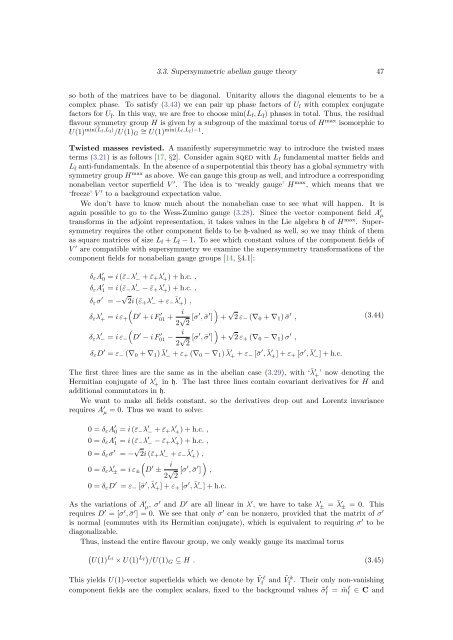The Bethe/Gauge Correspondence
The Bethe/Gauge Correspondence
The Bethe/Gauge Correspondence
You also want an ePaper? Increase the reach of your titles
YUMPU automatically turns print PDFs into web optimized ePapers that Google loves.
3.3. Supersymmetric abelian gauge theory 47so both of the matrices have to be diagonal. Unitarity allows the diagonal elements to be acomplex phase. To satisfy (3.43) we can pair up phase factors of U f with complex conjugatefactors for U¯f. In this way, we are free to choose min(L f , L¯f) phases in total. Thus, the residualflavour symmetry group H is given by a subgroup of the maximal torus of H max isomorphic toU(1) min(L f,L¯f) /U(1) G∼ = U(1)min(L f ,L¯f)−1 .Twisted masses revisted. A manifestly supersymmetric way to introduce the twisted massterms (3.21) is as follows [17, §2]. Consider again sqed with L f fundamental matter fields andL¯f anti-fundamentals. In the absence of a superpotential this theory has a global symmetry withsymmetry group H max as above. We can gauge this group as well, and introduce a correspondingnonabelian vector superfield V ′ . <strong>The</strong> idea is to ‘weakly gauge’ H max , which means that we‘freeze’ V ′ to a background expectation value.We don’t have to know much about the nonabelian case to see what will happen. It isagain possible to go to the Wess-Zumino gauge (3.28). Since the vector component field A ′ µtransforms in the adjoint representation, it takes values in the Lie algebra h of H max . Supersymmetryrequires the other component fields to be h-valued as well, so we may think of themas square matrices of size L f + L¯f − 1. To see which constant values of the component fields ofV ′ are compatible with supersymmetry we examine the supersymmetry transformations of thecomponent fields for nonabelian gauge groups [14, §4.1]:δ ε A ′ 0 = i (¯ε − λ ′ − + ¯ε + λ ′ +) + h.c. ,δ ε A ′ 1 = i (¯ε − λ ′ − − ¯ε + λ ′ +) + h.c. ,δ ε σ ′ = − √ 2i (¯ε + λ ′ − + ε −¯λ′ + ) ,(δ ε λ ′ + = i ε + D ′ + i F 01 ′ +i )2 √ 2 [σ′ , ¯σ ′ ] + √ 2 ε − (∇ 0 + ∇ 1 ) ¯σ ′ ,(δ ε λ ′ − = i ε − D ′ − i F 01 ′ −i )2 √ 2 [σ′ , ¯σ ′ ] + √ 2 ε + (∇ 0 − ∇ 1 ) σ ′ ,δ ε D ′ = ε − (∇ 0 + ∇ 1 ) ¯λ ′ − + ε + (∇ 0 − ∇ 1 ) ¯λ ′ + + ε − [¯σ ′ , ¯λ ′ +] + ε + [σ ′ , ¯λ ′ −] + h.c.(3.44)<strong>The</strong> first three lines are the same as in the abelian case (3.29), with ‘¯λ ′ +’ now denoting theHermitian conjugate of λ ′ + in h. <strong>The</strong> last three lines contain covariant derivatives for H andadditional commutators in h.We want to make all fields constant, so the derivatives drop out and Lorentz invariancerequires A ′ µ = 0. Thus we want to solve:0 = δ ε A ′ 0 = i (¯ε − λ ′ − + ¯ε + λ ′ +) + h.c. ,0 = δ ε A ′ 1 = i (¯ε − λ ′ − − ¯ε + λ ′ +) + h.c. ,0 = δ ε σ ′ = − √ 2i (¯ε + λ ′ − + ε −¯λ′ + ) ,(0 = δ ε λ ′ ± = i ε ± D ′ ±i )2 √ 2 [σ′ , ¯σ ′ ] ,0 = δ ε D ′ = ε − [¯σ ′ , ¯λ ′ +] + ε + [σ ′ , ¯λ ′ −] + h.c.As the variations of A ′ µ, σ ′ and D ′ are all linear in λ ′ , we have to take λ ′ ± = ¯λ ′ ± = 0. Thisrequires D ′ = [σ ′ , ¯σ ′ ] = 0. We see that only σ ′ can be nonzero, provided that the matrix of σ ′is normal (commutes with its Hermitian conjugate), which is equivalent to requiring σ ′ to bediagonalizable.Thus, instead the entire flavour group, we only weakly gauge its maximal torus( )U(1)L f× U(1) L¯f /U(1)G ⊆ H . (3.45)This yields U(1)-vector superfields which we denote by Ṽ fl and Ṽ ¯f k . <strong>The</strong>ir only non-vanishingcomponent fields are the complex scalars, fixed to the background values ˜σf l = ˜m l f∈ C and
















